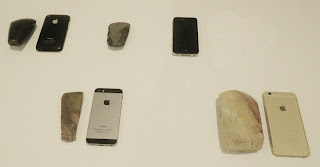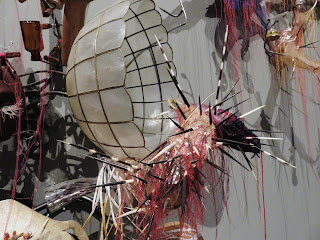This year we did
not find much of great interest in the Giardini national pavilion exhibitions.
I missed the moving tree from last time’s French pavilion, the deconstructing
Russian pavilion after 1989, the Hans Haacke broken up floor many years ago in the
German pavilion, and definitely “Take Care of Yourself,” the Sophie Calle from
years ago in the French pavilion, which I have seen at least two more times and
which Tom and I still quip about in everyday conversations.
There are several
pleasures in going through the Giardini, though, despite the still very limited
dining opportunities and the exhaustion and heat. The pavilions themselves are worth
looking at as examples of 20th-century architecture. This year the
Venezuelan pavilion paid special attention to its architect, Carlo Scarpa(1906-1978), who designed it in 1954. Scarpa was mentioned very frequently this
year and his modernist architecture was much celebrated. Because of the focus,
I paid attention to some of the details of the Venezuelan pavilion, which looks
very simple and straightforward, but has varied materials and textures.
Goeffrey Farmer
took most of the Canadian Pavilion down in order to install an group of
fountains, the central one spouting like a geyser, art nouveau iridescent glazed
tiles.
and the Australian Pavilion has been demolished and rebuilt. The artist there, Tracy Moffett, exhibited fictive film
stills, perhaps inspired by Cindy Sherman, but without the artist’s presence
and more theatrical. Uruguay was closed
for some reason although there are descriptions of the facsimile of a cattle
chute Mario Sagradini had made for it. The American pavilion is neoclassical,
very Washington, D.C., lending itself to the images of a deteriorating, failing
structure that artists often like to give it, this year’s work by Mark Bradford
being no exception. I’ve always loved the Hungarian pavilion, built in 1909, with its art nouveau iridescent glazed tiles. And although the show itself didn't grab out attention, we appreciated the thought.
Only a few
exhibitions in pavilions captured our interest this year, and I was interested
in more of them than Tom. We both very much liked the Russian pavilion work by
Grisha Bruskin, dystopian but tongue in cheek, I thought. Generally I find
Bruskin’s work rather mannered, but in this installation it had an impact,
possibly because it seemed to warn against dictatorship, representing an
autocratic country. In one room huge projections flash over white sculptures
inscribed with book titles, concepts, aphorisms. Another is filled with strange
vessels and objects, all looking threatening.
Also in the Russian pavilion, Recycle Group did a project called
“Blocked Content,” in which figures or parts of figures emerge from white
angular blocks on the walls. Inspired by the ninth and worst circle of Hell in
Dante’s Divine Comedy (the circle of treason and betrayal), where sinners are
encased in ice, the artists encased human figures in these blocks for cyber
crimes – spam, retailing viruses, fake celebrities. In poetic justice, the
complete figures can be seen through an I-Phone app.
Yet another book
project was in the Nordic pavilion. One of the six artists exhibiting there, filmmaker
Mika Taanila (b. 1965 Finland) cut through the pages of cinema books to create
three dimensional versions of the book’s subjects.
I enjoyed
Phyllida Barlow’s crowded installation of the Great Britain pavilion. I only
learned about her at a recent Biennale, at the time when her decades-long sculptural
production was coming to attention, and I appreciated that after working for so
long in obscurity she was chosen to represent Britain this year. Her huge, very
rough sculptures were almost impossible to see, jammed into the rooms of the
pavilion, and crowding around the entranceway as well. There’s a kind of
abandon to them, and I got the sense that she was going to squeeze as much she
wanted in that space. Being close to the American pavilion, where Mark Bradford’s
introductory sculpture left little room for the viewer, it felt a little as if
the sculpture is in revolt against the viewer.


The French
pavilion was transformed into a very elaborately designed working recording
studio, all angled bare wood. People were working in it. I didn’t see how that
was visual art, except that the angled walls in blonde wood were lovely
architecture. Tom liked it.
At the Israel
pavilion a huge cloud form dominated the upper level, a concrete manifestation
of the cloud of vapor that results from a missile launch, by Gal Weinstein. On
the walls and floor of much of the building he installed panels covered with
steel wool made to represent mold he found in his studio, giving the modernist
building a mood of decay, some of it in the patterns of wallpaper. I’m not sure
if his intention was to suggest institutional, political or cultural decline,
but that was my sense of it.
I thought the
Venice pavilion, celebrating the most fabulously expensive luxury goods made in
Venice, and advertising for them, was vulgar, and I left it as quickly as I
could. Some years this pavilion has celebrated Venetian art and design in a
much less commercial fashion; I kept thinking they must be trying to parody the
excesses of wealth, but that’s not how it came over.
The German pavilion was highly regarded, but it was a performance and we did not want to take the time to wait in line for entrance, so we skipped it. I later found that its subject would have been disturbing, so I'm not sorry. We did look at the pair of Rottweilers caged in front of the building.









































